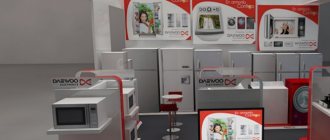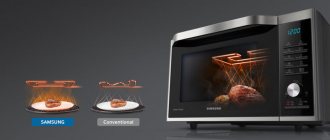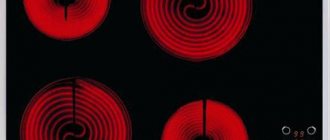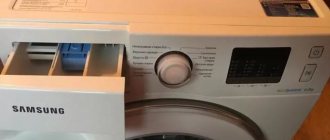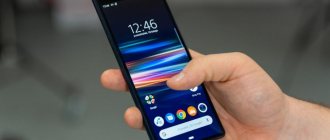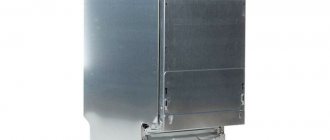While home theater connoisseurs were admiring innovative technologies in the segment of curved TVs and multimedia projectors, manufacturers of audio-video equipment formed another independent niche. It is based on the concept of a projection TV. For several years now, there has been fierce competition on the market between projectors and TV devices, which have fundamentally different pros and cons - almost opposite.
And it is quite logical that against this background a development appeared that combines two seemingly incompatible ideas. This is not to say that projection televisions are a completely new concept, but its modern implementation is not even close to its analogues, which were developed at the dawn of the television era.
What are the features of projection TVs?
Externally, such models differ little from ordinary televisions - more precisely, from those that were produced about 10 years ago. At first glance at the projection device, its thickness may seem strange, because even budget modern TVs for the most part have thin screens.
In this case, the thickness can be 30-40 cm. And this is due precisely to the operating principles of this technique. The thick case hides a projector that casts rays onto a translucent screen through a mirror system. Technically, this principle is implemented in different ways.
We hope that after reading this article, you will be able to understand what type of TV is right for you. At the same time, this text is not an exhaustive guide, but rather advice to help beginners.
All TVs can be divided into 2 categories - those that leave “burns” (“the phosphor burns out” in certain places), and those that do not leave them. The first use electrons to excite a phosphor, which illuminates dots on the screen. Over time, the phosphor may fade. This happens gradually and our eyes become accustomed to these slow changes on our TV screen. Actually, we notice “burn-in” when the phosphor burns out prematurely in certain areas of the screen. Most often this happens in places where static images are located, for example, logos of television channels.
Another source of a similar problem is watching TV programs in 4:3 format on a widescreen TV, while part of the screen always remains black, the picture in this part will look brighter than in the middle of the screen.
CRT monitors and televisions belong to the first group of devices we identified (which leave “burns”). A cathode ray tube directs electrons to a phosphor layer coated on the glass. Projection CRT televisions (rear projection, more about this type of television below) and plasma screens also use variations of this technology. If you've never seen a rear projection TV, imagine a small 7-9 inch CRT TV with a picture so bright that the image is projected from the inside onto an external screen. Plasma TVs also use a phosphor, but the energy is transmitted to it in a completely different way than in CRT monitors.
In projection CRT televisions and plasma screens, much more energy is transferred to the phosphor than in conventional CRT televisions, so the problem of “burn-in” and burnout of the phosphor is much more pressing for them.
The second group of TVs we have conditionally identified (which do not leave “burns”) uses a transparent or reflective color filter and a bright backlight (as in an overhead projector). Therefore, such TVs are not afraid of any “burning”. Projection TVs use high-intensity lamps, the same as those found in the headlights of luxury cars. They lose their original brightness after 2000–5000 hours of operation, depending on the manufacturer. These lamps cost approximately $200–300 and can be easily replaced. This approach is used in LCD, DLP and LCoS projection TVs (more about these types of TVs below). Flat LCD panels also fall into this category of devices, but they are backlit by several cool fluorescent lamps.
Color and Contrast
For phosphor-based devices, reproducing black is not a problem, you just shouldn't highlight the desired area.
On the other hand, devices such as LCD monitors have to block out as much light from the lamps as possible, and may end up with dark gray instead of the original black.
This is one of the factors that allows us to say that TVs with burn marks on their screens can offer a better picture than others. Still, we wouldn't recommend buying phosphor-powered TVs if you (or anyone in your household) plan to play video games more than 25% of the time the TV is used, or if you prefer to watch TV in 4:3 format without stretching the picture in full screen.
Screen diagonal
Many people believe that the diagonal of the screen should be at least a third of the distance from the viewer’s eye to the screen.
So, if you are 8 feet (2.4 meters) away from the screen, you will need a TV with a diagonal of at least 32 inches (81 cm), if at a distance of 4.8 meters - 65" (165 cm). As defined by the Society of Motion Picture and Television Engineers, a real movie theater should have a 30-degree viewing angle. This means that to view from 2.4 meters away, you will need a 60-inch TV. If you're building a system that meets the THX (Tomlinson Holman eXperiment) standard, the viewing angle must be 36 degrees. That is, to view from a distance of 2.4 meters you need a TV with a diagonal of 72". The numbers will seem terrible to many; few people implement these requirements in practice.
Let's decide whether you are going to hang the new TV on the wall? If yes, then there are two choices - a plasma TV or an LCD panel. Let's look at them in a little more detail.
Plasma TVs
EDTV “plasma”, price range: $1,500–3,500;
diagonals 37–46 inches. HDTV (High Definition Television) “plasma”, price range: $2,500–20,000; diagonals 32–61 inches. Enhanced definition plasma screens do not offer the same quality as HDTV. EDTV screens are “DVD quality” and have a resolution of 852 x 480. For watching DVDs, regular cable television, broadcasting, and video games, the lower resolution (compared to the requirements of HDTV) does not play a big role. In addition, by purchasing an EDTV TV, you will be able to enjoy HDTV TV shows in the future, although they will not look better than DVDs. By general agreement, plasma screens with a resolution greater than 852 x 480 are considered “HDTV plasma”.
Such resolutions include, for example, 852 x 1024, 1024 x 768, 1024 x 1024, 1280 x 768, and 1366 x 768. And such TVs are needed only for those who are going to watch HDTV broadcasts
Flat LCD panels
Price range: $500–$10,000;
diagonals 17–46 inches. LCD panels, as a rule, are inferior to plasma in terms of picture quality and maximum dimensions. The indicated price range may lead to incorrect conclusions. A 46" LCD TV really costs about $10 thousand, and plasma panels of the same size are 2 times cheaper. But at the same time, small LCD TVs are cheaper than “plasma” TVs with a similar diagonal.
Thus, LCD TVs operating with high definition signals (HD, for example, 1280 x 768), with a 30" screen diagonal, cost approximately $1000, much cheaper than similar plasma screens.
An LCD screen is best suited for those who are planning to buy a TV with a diagonal of 30" or less. The picture quality of LCD TVs is almost the same as that of plasma TVs, but the former are more reliable. If you are not going to play on a TV and are looking for a good screen for watching DVDs and EDTV, then plasma TVs are also a good choice. If you are buying something expensive, want a large diagonal screen - 50-60 inches - and have $5,000-10,000 at your disposal, then you won’t find anything better than “plasma”.
Now let's look at TVs that are not supposed to be hung on the wall.
Of course, flat panels look great, but the price factor is also important. For most people, projection technologies seem to be the most realistic choice. There are two types of projection TVs: those projecting onto a light-transmitting screen (rear projection - RPTV) and those projecting onto a reflective screen (front projection - FPTV). The latter offer the largest screen size, but they are difficult to find the right location in the room - they require a dark room and a dedicated screen (rather than a bare wall) to get the best results. Let's focus our attention on RPTV.
CRT RPTV
Price range: $1500–2500;
diagonals - 47–65 inches. These are large, heavy TVs that use a lot of power. It is impossible to enjoy high-quality images in daylight. The viewing angle is very small, so you need to sit in front of the screen. Over time (years) defocus occurs. CRT RPTV is the cheapest large screen TV technology for those who don't mind always watching TV sitting in front of the screen in a dark room. Moreover, in such conditions, the image quality is better than that of TVs of other technologies.
This is no joke: a $2,500 65" RPTV will have a better picture than a $15,000 plasma screen.
Burn-ins are possible, but given the price, such a TV can be replaced more often than TVs of other technologies. The real downside is the size. Are you moving soon? Will the TV fit into a new apartment without remodeling?
Three-chip LCD (LCD) RPTV
Price range: $2500–$7000;
diagonals - 42–70 inches. The idea behind LCD RPTV is the same as that of a diascopic projector. Light from a very bright lamp is split into three polarized components - red, blue and green. The LCD panel controls the amount of light that reaches the screen for each color component. When they are mixed, a color picture is obtained.
The components of color are projected onto each other, unlike the pixels in CRT or flat panel LCD monitors, which are made up of individual subpixels very close together. In general, LCD RPTVs produce better colors than computer monitors.
3-chip LCDs produce superior colors and better brightness than RPTV CRTs. These are quite light and thin TVs - about 30 centimeters in thickness - which provide large viewing angles.
However, the problem of “gray black” remains. In addition, the image obtained using the LCD panel loses a little in clarity.
TVs with single-chip DLP
Digital Light Processing - digital processing of light flux.
A bright lamp in such TVs illuminates a group of almost a million microscopic mirrors (TVs with three-chip DLP have 3 groups of mirrors). Each of them can be rotated so that light is reflected towards the screen and in the opposite direction from it. The mirrors rotate up to several thousand times per second. Mirrors very quickly switch between on/off states - they direct the light towards the screen (on) or to the side (off) - this is how the color turns out to be gray. To obtain a color image, lamp light is passed through a rotating color filter. A red square on a screen that changes to blue after a thousandth of a second appears purple to the human eye. The contrast and brightness of DLP TVs are better than projection LCD TVs, and the picture appears clearer.
Unfortunately, the rotating light filter of single-chip DLP TVs cannot produce colors as pure as three-chip models.
Due to the filter, in black-and-white or very fast-moving scenes, you may notice a “rainbow effect” around the edges of the image. Imagine a purple square moving across the screen. If the red and blue do not overlap perfectly, you will see a purple square with a blue and red border. Most consumers do not notice this effect. However, some people complain of headaches after watching a movie on a single-chip DLP screen. To reduce the “rainbow effect”, expensive TVs provide a higher speed of rotation of the light filter compared to low-budget ones. In the next five years, there will likely be cheaper RPTVs with three-chip DLP that will mitigate the problem, but until then, the rainbow effect is DLP's Achilles heel.
LCoS TVs
1-megapixel single-chip LCoS, price range: $3500–4000;
diagonals - 55–62"; 1-megapixel three-chip, price range: $3500–4500; diagonals - 52–61"; 2-megapixel three-chip LCoS, price range: $8000–20000; diagonals - 60–82". LCoS - liquid crystals on silicon - is considered the technology of the future today. This is a variation of LCD technology, only here the light reflects off the colored LCD panel rather than passing through it. This may well give results that are superior to DLP TVs in terms of brightness and contrast. Like single-chip DLP TVs, single-chip LCoS (made by Philips) use a rotating filter, so the "rainbow effect" can also be an issue.
However, most LCoS are three-chip and produce the same colors as three-chip LCDs. Moreover, whereas conventional DLP and LCD projection TVs are limited to approximately 1 million pixels, three-chip LCoS offers resolutions of up to 2 megapixels.
With the contrast and brightness of DLP, the colors of three-chip LCDs and the very high resolution of 1920 x 1080, LCoS is the best technology out there. The main disadvantage of such TVs is the price.
Very few people can afford LCoS TVs. The price/quality ratio is better for DLP and LCD RPTV.
People often underestimate projection RPTV-CRT TVs, although such TVs are an opportunity to get an excellent picture for little money. If you play video games less than 25% of the time on your TV and are comfortable with the idea of watching movies in a dark room, this is an option worth seriously considering. RPTV provides the best picture of any technology, at least while you're sitting in front of the screen in a dark room.
For most people, DLP and LCD RPTV provide the best balance of performance, price and reliability.
If we dwell on these two technologies in more detail, a number of points should be noted. Firstly, we must not forget about the “rainbow effect” of DLP TVs. Ask the store to show a fast-paced movie on your DLP TV and see if you see a “rainbow effect” in fast-moving images or in black-and-white scenes. If so, then you shouldn’t buy such a TV, no matter how cheap it is: your head will hurt after watching it. If not, then you are in great shape, TV may well be for you. The next step is to ask to see the LCD RPTV. You will need to compare the color rendition of two TVs you like standing next to each other. If the seller is conscientious, then the TVs will be calibrated (usually according to the “pro-configuration”, warm white). But sellers rarely calibrate TVs this way, so try not to look at brightness (which is achieved by cooler whites), but at which of the two has more natural color transitions and tones. See if better LCD RPTV color reproduction is important to you personally.
If not, then you can opt for a DLP TV. If the color of an LCD RPTV is significantly better, you need to compare the picture quality from the distance at which you will watch TV at home. You need to look at the clarity of the picture and the presence of a “grid effect”. If you don't notice it, then you can easily stick with LCD RPTV.
Varieties of projection methods
There are two common projection technologies: electron beam and liquid crystal. In the first case, CRT tubes are used that emit weak light. As a rule, these are massive structures that produce a very modest “picture” in both brightness and resolution.
Lamps for projection TVs with an LCD matrix provide better results. In this case, LCD technologies are used, which in some variations allow the light flux to pass through several matrices, which significantly improves the image quality. The latest technologies in this area are associated with digital processing of light fluxes DLP. This development uses micromirror matrices and sector filters, the combination of which provides even higher image quality.
Projection TV design
There are devices with front and rear projection (it should be noted that the production of the latter has been discontinued since 2014). The picture will begin to “emerge” in a small source using CRT tubes or an LCD display. Then, through a system of optical lenses, it is transmitted to the screen.
The device includes the following parts:
- projector with optical system;
- boards responsible for creating the original image;
- backlight;
- lenses and mirrors;
- cooling system.
Model KDF-E50A11E from Sony
Not the most expensive and quite high-quality model from a large Japanese manufacturer - a good option for those who are looking for a balanced solution. The model, with modest technical parameters, provides a bright and contrasting image even in conditions of active local lighting.
In terms of communication capabilities, this option is in no way inferior to modern plasma panels - all the necessary connectors are present, including digital HDMI. If we talk about features, the Sony projection TV in the KDF-E50A11E modification is characterized by a short response time and excellent color rendition. The weak points are insignificant - for example, users note the unsuccessful implementation of the remote control.
LG PF-44SZ35 TV parameters
This TV is produced with a diagonal of 42 inches. The surge protector is provided with a large diameter. The model does not have an oil film. The difference between this projection TV lies in the presence of the Eidor system. It primarily helps in image scaling. The device also has systems to improve detail. The model has no problems with color depth. The optical system is set at a frequency of 130 Hz. You can buy this projection TV for about 55 thousand rubles.
Model SP-43T6HFR from Samsung
Samsung is one of the three or four companies that set fashion in the television equipment segment. However, the brand’s success in the niche of projection models is not so obvious. In particular, the 43-inch version of the TV, equipped with a Dolby Pro-Logic decoder and digital signal processor, deserves attention.
The model is also equipped with a DVD player, a headphone jack, a 60-watt speaker system and two tuners. What’s also important is that the Samsung projection TV in this design still focuses on merging digital and analog communication connections. The developers did not abandon the S-VIDEO and SCART connectors, which have not yet completely lost their relevance.
Otherwise, the modification is also quite conservative in its functions and image quality. But, again, the low price tag will justify such a purchase.
Model 43CJ7DR from Toshiba
With Toshiba the situation is the opposite. The company remained in oblivion for quite a long time, occasionally surprising fans with individual developments in various areas of radio equipment. However, projection televisions have enlivened the minds of Japanese engineers, who have come up with several interesting models.
The segment concept is most clearly demonstrated by the 43CJ7DR modification, the operation of which is based on three Pegasus-3 cathode ray tubes. Despite the outdated principle of delivering light flux, the output image is bright, detailed and rich.
As for other technical and operational qualities, the model supports NICAM stereo sound, has one independent TV tuner, PrTV CRT technology, etc. With such equipment, the Toshiba projection TV may be of interest to ordinary fans of comfortable home movie viewing, but against the backdrop of modern technological development that Plasma is no longer enough.
Review of JVC HV-23PRO
These projection TVs are no longer sold in stores. However, they used to be in great demand. The model works standardly on the principle of rear projection. The device does not have backlight technology. Many buyers praise the model for its high-quality picture tube. It takes up a lot of space, but is distinguished by its reliability. The matrix is responsible for the image quality. In this case, it is installed with a micromirror device.
Laser projection occurs due to the light valve. There is no oil film on this projection TV. It is also important to note that this model supports the Eidor system. Thus, there are no problems with scaling in the device. The screen diagonal is 45 inches.
A front CA output is provided on the panel. The screen refresh rate is at 120 Hz. The said projection TV weighs exactly 34 kg. The model does not have a bass amplifier. However, it is important to mention that there are two powerful surround sound speakers.
The color accuracy of the device is high. The optical system involves the use of a lamp. In this case, it is located together with microscopic mirrors. The light filter is responsible for the formation of rays. The model has no problems coordinating the tilt of the mirrors. Moving between light sources occurs quickly.
Model RE-44SZ21RD from LG
Korean specialists also did not delve into innovative developments and offered a solid, well-assembled and generally well-thought-out product. The model has a contrast ratio of 600:1 and a high brightness value of 450 cd/m2.
The lamp, whose power is 120 W, deserves special attention. According to the manufacturer, its resource is enough for 8,000 hours of operation. There are few complaints about the model regarding the quality of the “picture”. On the contrary, users point to the optimal ratio of image parameters, supported by a good resolution of the 1024 x 576 format. But, again, the LG projection TV in this version does not indulge in functionality. The company has provided only the necessary options, including PrTV DLP technology and the picture-in-picture function.
Parameters of JVC HV-44PRO
These projection TVs are sold with a high-quality stand. The micromirror device is used without a light filter. The model works on the principle of rear projection. Illumination technology is provided in this case. The kinescope of this model has a large diameter. The matrix is standard used in the LCD series.
The model's lamp uses low power. Also worth mentioning is the high-quality optical system. According to buyers, the model has excellent detail. Microscopic mirrors are responsible for the formation of shades in the device. This projection TV costs around 60 thousand rubles.
Positive reviews about projection TVs
This technology has made it possible to implement almost all the advantages that multimedia projectors have in a conventional television form factor. Owners of such devices note high resolution, large horizontal viewing angles, as well as brightness, which can exceed that of plasma models.
In addition, owners who are faced with the need for repairs point to the availability of components and the low cost of service work. In terms of maintainability, projection TVs really outperform plasma and liquid crystal technology. If the LCD TV screen breaks, restoring it will cost almost half the full price of the product. In the case of projection models, this cost is several times lower, as are the TVs themselves.
As for lamps, they do change more often, but they are also inexpensive. However, there is, of course, no talk of complete similarity with projectors. And such a merger provided a number of shortcomings that are worth discussing separately.
Thomson 50DLY644
In addition to a large screen, this projection TV has high-quality microscopic mirrors. The model rarely has problems with grain. The angle of the mirrors in the device is small. It is also important to note that there is only one light valve installed. If necessary, the brightness on the projection TV can be adjusted. The model's kinescope uses the ST series.
The connectors in this case are installed on the bottom panel. The presented projection TV does not support the Eidor system. The screen refresh rate is 130 Hz. This model weighs exactly 34 kg. Considering this, the owner may have problems installing it. You can buy this projection TV for 40 thousand rubles.
Negative reviews
The disadvantages of such TVs include geometric distortion, large dimensions and noisy operation of the cooling system. As for distortion, this drawback concerns small vertical viewing angles. As mentioned above, the perception of the image from a horizontal angle is normal and does not cause any complaints, but if you lift yourself above the screen or look from below, you can only see a black canvas.
With large sizes the situation is also clear. The models are criticized for their great depth - that is, the body must also occupy free space at the back. For example, the Toshiba projection TV discussed above, together with the stand, is 51 cm thick. Of course, this is inconvenient for those who are already accustomed to flat compact screens.
A separate line of critical reviews is devoted to the loud operation of the cooling system, the presence of which is simply necessary in equipment with powerful lamps. However, this drawback is not universal and depends on how well the sound insulation of a particular model is performed.
Opinion about LG PF-44SZ40
This TV has the following parameters: diagonal - 38 inches, frequency - 130 Hz, total weight - 35 kg. The micromirror device is installed on a high-quality model. According to the owners, the kinescope rarely breaks. The matrix copes well with color reproduction. The presented projection TV supports the Eidor system. A light filter is used in conjunction with an oil film.
Laser projection is carried out thanks to a semiconductor. The model's lamps use high power. The projection TV has a total of two speakers. Today you can no longer buy this model in a store that sells consumer electronics.

